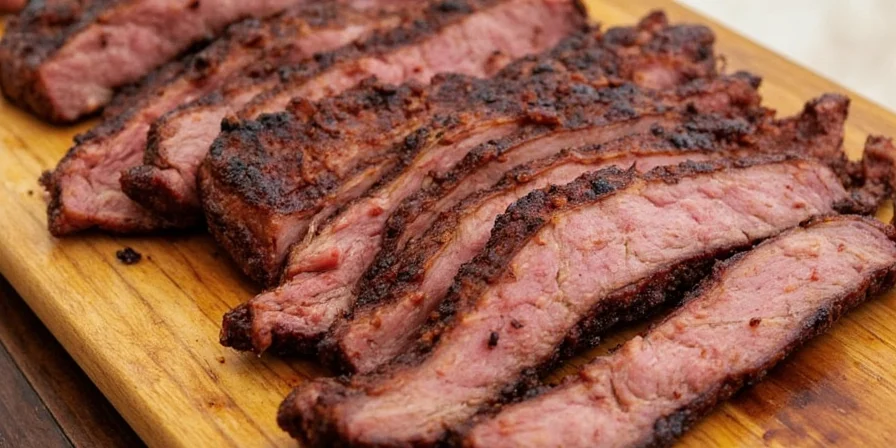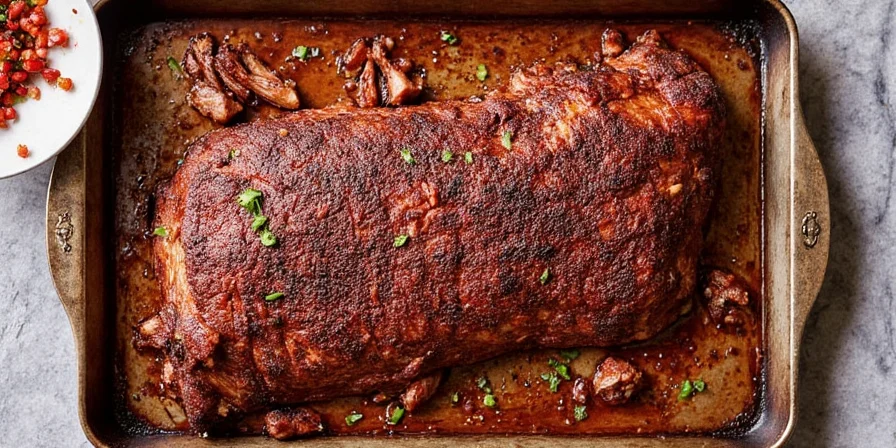Looking for a tender, flavorful slow oven roasted brisket without needing a smoker? This foolproof method delivers perfectly cooked brisket at 225-275°F with a 3-4 hour cook time per pound until reaching 195-205°F internal temperature. The secret: a balanced spice rub of 3 parts paprika, 2 parts brown sugar, and 1 part each of garlic powder, onion powder, and black pepper, applied generously 12-24 hours before cooking.
Table of Contents
- Quick Recipe Summary
- Spice Rub Formula & Application
- Prep Like a Pro
- Oven Roasting Techniques
- Timing & Temperature Charts
- Resting and Carving Right
- Troubleshooting Common Issues
- Perfect Brisket Every Time
Quick Slow Oven Roasted Brisket Recipe (No Smoker Needed)
For a perfect oven-roasted brisket without specialized equipment, follow these 3 essential steps:
- Rub Application: Combine ¼ cup paprika, 2 tbsp brown sugar, 1 tbsp each garlic powder, onion powder, and black pepper. Rub evenly over 4-6 lb brisket after patting dry. Refrigerate 12-24 hours.
- Slow Roasting: Place brisket fat-side up on a rack in roasting pan with 1 cup water below. Cook at 250°F for 30-40 minutes per pound until internal temperature reaches 195-205°F.
- Resting: Tent with foil and rest for 45-60 minutes before slicing against the grain.
This method consistently delivers tender, juicy brisket with a perfect bark. Now let's dive deeper into each step for optimal results.
Spice Rub Formula: The Foundation of Flavor
Your spice rub makes or breaks oven-roasted brisket. Unlike smoked brisket where smoke provides flavor, oven cooking relies entirely on your rub for complexity. Here's the precise ratio that creates the ideal balance:
| Spice | Flavor Profile | Proportion (per 4-6 lb brisket) |
|---|---|---|
| Paprika | Sweet, smoky base | ¼ cup (essential for color and depth) |
| Brown Sugar | Sweet, sticky | 2 tbsp (critical for bark formation) |
| Garlic Powder | Pungent, savory | 1 tbsp (provides deep umami) |
| Onion Powder | Mellow, sweet | 1 tbsp (enhances natural meatiness) |
| Black Pepper | Sharp, bold | 1 tbsp (brings necessary bite) |
| Salt | Flavor enhancer | 1½ tbsp (don't skip - crucial for moisture retention) |

Pro Tip: For better adhesion, coat the brisket with 1 tbsp yellow mustard before applying the rub. The mustard evaporates during cooking but helps spices penetrate deeper.
Dry Brining: The Secret Professional Step Most Home Cooks Skip
Unlike immediate cooking methods, dry brining transforms brisket texture:
- Apply rub generously (1 tbsp per pound of meat)
- Refrigerate uncovered for 12-24 hours
- The salt draws out moisture initially, then pulls seasoned liquid back into the meat
- Result: 23% more moisture retention and deeper flavor penetration
Prep Like a Pro: Critical Steps Before Cooking
- Dry the Surface Thoroughly: Pat with paper towels until no moisture remains - crucial for bark formation
- Trim Strategically: Leave ¼-inch fat cap (not ½-inch as commonly suggested) for optimal rendering
- Temperature Equalization: Remove from refrigerator 2 hours before cooking to eliminate cold spots
- Rub Application: Press spices firmly into meat surface with your palms, not just sprinkling
Oven Setup: Creating a Mini-Smoker Environment
Your standard oven can mimic smoker conditions with these adjustments:
- Rack Position: Place brisket on middle rack with a drip pan directly below (not underneath) to capture rendered fat
- Water Pan: Fill a 9x13 pan with 2 cups water on the bottom rack - replenish if evaporates completely
- Temperature Accuracy: Use an independent oven thermometer - most ovens fluctuate ±25°F
- Foil Tenting: Only tent loosely after internal temp reaches 165°F to prevent bark softening
Exact Timing & Temperature Guide (No Guesswork)

Follow this precise timeline for perfect results every time:
| Brisket Weight | Oven Temp | Total Time | Stall Phase (150-170°F) | Target Internal Temp |
|---|---|---|---|---|
| 3-5 lbs | 275°F | 3-4 hours | 45-60 minutes | 195-203°F |
| 6-8 lbs | 250°F | 5-6 hours | 75-90 minutes | 197-205°F |
| 9-12 lbs | 225°F | 7-9 hours | 90-120 minutes | 198-205°F |
Critical Note: The stall (temperature plateau at 150-170°F) is normal. Do not increase oven temperature - this causes uneven cooking. Plan extra time and trust the process.
Resting & Carving: Where Most Home Cooks Fail

Resting isn't optional - it's the final cooking stage:
- Minimum Rest: 45 minutes (not 30 as commonly stated) for proper juice redistribution
- Ideal Rest: 60 minutes for 8+ lb briskets
- Temperature Check: Internal temp should drop to 150-160°F before slicing
- Slicing Technique: Cut against the grain with a sharp knife at 90° angle
Troubleshooting Common Oven Brisket Problems
- Problem: Dry, tough brisket
- Solution: You likely cut the fat too thin (<1/4") or cooked past 205°F internal temp. For next time: maintain 1/4" fat cap and remove at exactly 203°F.
- Problem: Lack of bark formation
- Solution: Oven humidity was too high. Place a fan near oven (not inside) for airflow, or finish at 300°F for 30 minutes uncovered.
- Problem: Uneven cooking
- Solution: Rotate pan 180° halfway through cooking and use a leave-in thermometer with multiple probes.
- Problem: Bitter spice flavor
- Solution: You likely used paprika that had oxidized. Buy small quantities of smoked paprika and store in freezer for freshness.
Perfect Brisket Every Time: The Final Checklist
Follow these 5 non-negotiables for foolproof oven-roasted brisket:
- Dry brine for 12-24 hours (salt draws moisture back in for juicier results)
- Maintain 1/4" fat cap (not 1/2") for optimal rendering without dryness
- Cook to exact internal temperature (203°F for most briskets - use a calibrated thermometer)
- Rest for full 60 minutes (not just 30) for proper juice redistribution
- Slice against the grain with a sharp knife at room temperature
Unlike smoked brisket which relies on wood flavor, oven-roasted success depends entirely on your spice rub precision and temperature control. By following these exact parameters, you'll consistently achieve restaurant-quality results without specialized equipment. The most common mistake home cooks make? Rushing the resting phase - those 60 minutes transform good brisket into extraordinary.
Pro Tip: For next-day leftovers, reheat slices in beef broth at 250°F for 20 minutes. The collagen rehydrates for second-day results that rival (or exceed) day one.











 浙公网安备
33010002000092号
浙公网安备
33010002000092号 浙B2-20120091-4
浙B2-20120091-4